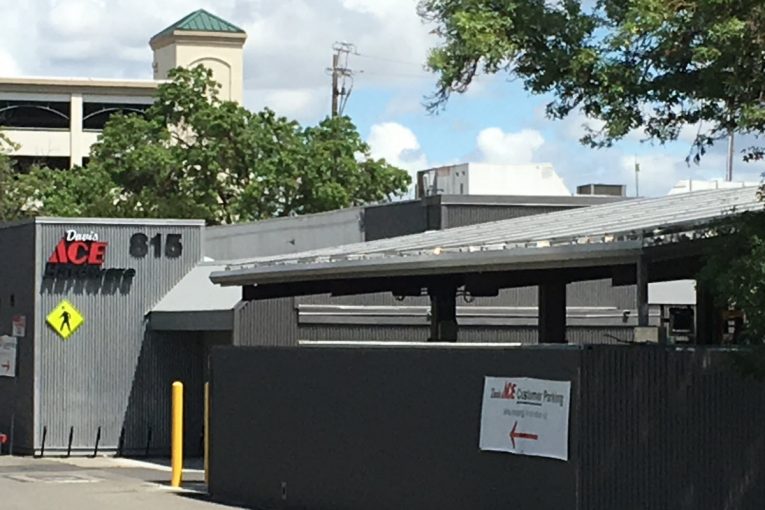

(From Press Release) – The City of Davis announced today that it is now requiring solar photovoltaics on all new non-residential buildings and any proposed high-rise, multi-family dwellings. The ordinance to amend city code also includes electric vehicle charging for new development.
The Davis City Council passed a new code amendment ordinance at its April 9 meeting. The new “Green Reach Code” builds upon an ordinance passed in 2014 requiring solar for all new single-family residential construction in the City limits.
Required solar photovoltaic systems must be sized to offset approximately 80% of electricity used on site or 15 DC watts per square foot of “solar zone,” meaning roof area amenable to a solar installation. Chief Building Officer Greg Mahoney reported that approval would “provide clarity and certainty of green building expectations for architects, developers, builders, staff and the community.” He added the new ordinance would “save time for construction applicants, staff and the Natural Resources Commission.”
The amended code details pre-wiring for Level 2 electric vehicle charging at single family residential developments and charging stations for all new non-residential settings including retail, hospitals and clinics, schools, churches, hotels and entertainment halls and venues, as well as new, multi-family developments. An additional measure addresses electrical sockets to accommodate future installations of on-demand, hot water recirculation pumps for new, single-family construction and some bathroom and kitchen remodels.
“The City of Davis was one of the first cities to require photovoltaic systems on all new single- family residential construction,” said Mayor Brett Lee. “We continue our leadership role in sustainability by now requiring photovoltaic systems on all new commercial and multi-family construction. These requirements will have long term benefits for our residents and our environment.”
Lee added, “Importantly, these requirements have been developed to be straightforward and clear so that they are manageable for designers and builders.”
The new rules are in alignment with the City Council goal of pursuing environmental sustainability and the Davis Climate Action and Adaptation Plan goal of carbon neutrality by 2040, a date moved forward 10 years by the Climate Emergency Resolution passed recently by Council.
“This new ordinance is an important step by our city to translate our recent city resolution that makes a commitment to addressing climate change into real, positive action,” said Councilmember Dan Carson. “The Natural Resources Committee, Cool Davis and the Davis Chamber of Commerce all embraced this proposal. It will reduce greenhouse gas emissions from new commercial and high-rise buildings by adopting energy-efficient standards while simplifying the steps that builders must take to comply with requirements.”
City staff conferred with the Davis Chamber of Commerce and the Natural Resources Commission on the new code proposal and utilized a cost-effectiveness study to determine some of the parameters of the ordinance. The new City of Davis code complies with California state energy code and reflects voluntary CALGreen Tier 1 measures.
Davis is already a leader in solar photovoltaic adoption in terms of capacity per capita. As of January 1, 2018, Davis had reached 735 watts per capita among a population of 68,704, more than the leader Honolulu as documented in the 2019 Shining Cities report. The Davis total was 50,535 kilowatts reported from PG&E interconnection data through November 2018. Smaller communities are included in the Shining Cities survey if they are state capitals.
This is the latest initiative taken by the City to keep Davis in a leadership position as a resilient, adaptive, and economically vibrant City. The joint Cool Davis and City of Davis Double Up on Solar campaign reports that our community has so far met about 80% of its 2020 goal of 4,500 total residential solar systems with 21 megawatts capacity.
Davis joins a handful of cities across the United States, including San Francisco, Santa Monica, Sebastopol and Watertown, Mass., that have passed ordinances requiring solar photovoltaics for commercial construction. The State of California is currently preparing for a residential solar mandate scheduled to go into effect January 1, 2020, and is looking into requiring solar on commercial new construction by 2030.
Davis can now add the Green Reach Code to a growing list of recent sustainability accomplishments, including LED street lighting and the establishment of local community choice energy provider, Valley Clean Energy.
Resource: Shining Cities Report 2019
https://environmentamerica.org/feature/ame/shining-cities-2019






. . . adding yet again to the cost of doing business in Davis.
But,
“it’s for the Davis image”, or perhaps, “it’s for the environment”… or…
Pretty sure that will save money over the long term
There have been times when I could go (financially) with the “long term”, and there have been times when I was in the “here and now”… and could not afford to think ‘long term’… but your point is valid, in general…
When more requirements are instituted, for ‘capital improvements’, it also figures in to purchase/construction price, financing (mortgages, for ex.), and property tax rates… all joined at the hip… and requiring a good spreadsheet analysis… does the energy cost savings pencil out for one’s financial time frame?
Maybe yes, maybe no… it depends… many variables, and the variables are variable… energy costs in 2019 may not be the same in 2029, 2039, etc. Might go up or might go down (I’d bet on the former)… interest rates and property tax rates, same…
With all the variables, and their potential variation, it isn’t “rocket science”, but comes close… the only “known” is what happens in the here and now… hence, I stand by who is the buyer/investor? Is this a “statement” (feel good thing) or “a wise investment” that the gov’t requires the builder/owner to adopt… I do not pretend to know… but am skeptical about the long term “value” for expenditures that will be incurred in the ‘here and now’… depends on the accuracy of one’s crystal ball, and one’s ‘risk tolerance’ in making current decisions…
Just saying… might be the ‘greatest thing since sliced bread’… or might have significant unintended and potentially negative) consequences… something in between… we’ll see… stay tuned…
“Is this a “statement” (feel good thing) or “a wise investment” that the gov’t requires the builder/owner to adopt”
I don’t see this as an either or. A “statement” in and of itself can be beneficial is it is itself either neutral or positive. It can inspire others to re-evaluate their own practices and find more areas in which the new model can be used. Many innovations in medicine have been accomplished by what were initially felt to be “feel good” approaches. Too often “feel good” is read to mean useless. It need not be. A feel-good approach can also be a “wise investment”, not the enemy thereof. As you say, in this instance time will tell.
Note the word “require”… were you “required” to do a specific technique @ Kaiser, or were you only required to achieve good outcomes?
Other than that, don’t disagree… it’s requiring a specific method/technique that bothers me, particularly not knowing if it is the “best” or only method/technique to achieve the goal…